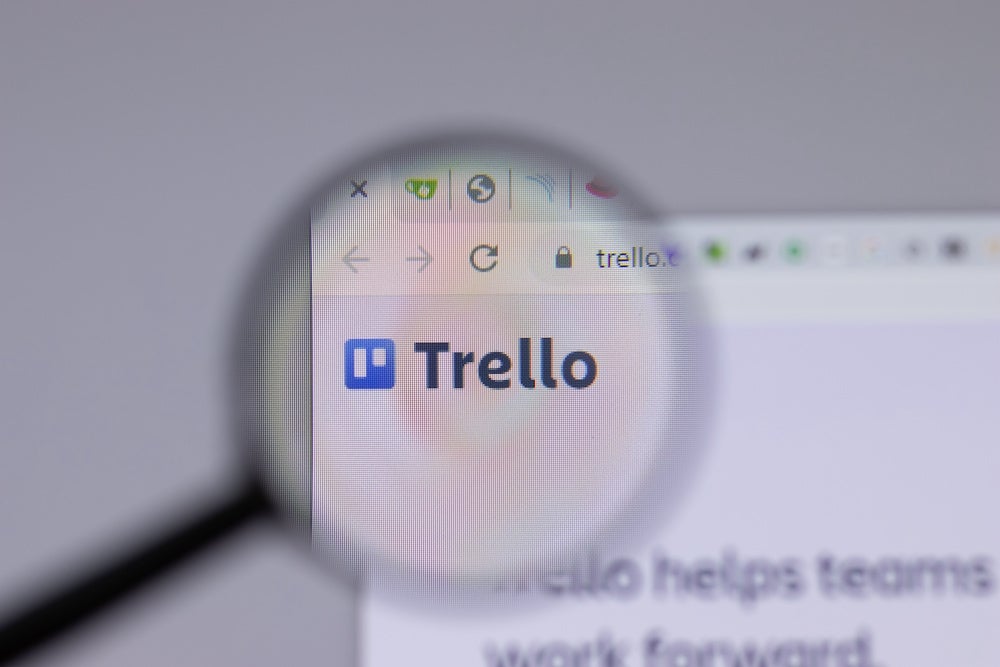Trello’s fast factsPricing: Starts at $5 per user per month, billed annually. Key features:
|

Trello is a project management software solution that stands out for its user-friendly interface and striking kanban board features. Its ease of use and straightforward pricing make Trello a popular choice for many teams. Trello’s built-in automation features further distinguish it from other competitors.
If your organization values a user-friendly platform with powerful kanban board features, Trello is worth considering. However, we have suggested a few alternatives if Trello is not ideal for you.
Featured partners
Jump to:
- Pricing
- Key features of Trello
- Trello integrations
- Pros of Trello
- Cons of Trello
- Trello alternatives
- Review methodology
Trello Pricing
Trello offers a free plan as well as three premium plans: Standard, Premium and Enterprise. In addition, Trello offers a 14-day free trial for its Premium plan.
Free
The free plan offers a variety of features that can meet the needs of individual users or small teams.
Standard
Trello’s Standard plan costs $5 per user per month, billed annually, and $6 per user per month, billed monthly. This plan offers good value for small teams, with added features such as unlimited storage, advanced checklists and custom fields.
Premium
The Premium plan costs $10 per user per month, billed annually, and $12.50 per user per month, billed monthly. This plan targets teams that need to keep track of and visualize multiple projects, offering additional features like 24/5 support, views and admin controls.
Enterprise
Trello’s Enterprise plan targets large teams that require more security and controls. It costs $17.50 per user per month, billed annually, at $210 for a team of 50 users. You can calculate the estimated cost of the software for between 50 to 5,000 users on the Trello pricing page.
Organizations with more than 5,000 users would have to reach out to Trello’s sales team to obtain pricing information.
Key features of Trello
Highly visual and customizable kanban boards
Trello’s highly visual and customizable kanban boards are arguably the best among its competitors. These boards (Figure A) make it easy for teams to visualize their projects and progress with drag-and-drop functionality that simplifies task management. Users can add labels, checklists and attachments to cards, ensuring all necessary information is easily accessible.
Figure A

Built-in automation features with Butler
Butler, Trello’s built-in automation tool, allows users to create rules, buttons and commands to automate repetitive tasks and streamline workflows. This feature saves time and reduces the potential for human error in task management.
Templates
Trello offers templates (Figure B) in the form of pre-designed board layouts that help users quickly set up and customize their projects according to their specific needs. These templates cover various use cases, such as product development, marketing and team collaboration.
With a plethora of uses, teams can easily adopt Trello for their workflows. By using templates, users can save time and effort in organizing tasks and focus on the core aspects of their projects.
Figure B

Collaboration capabilities
Trello fosters collaboration through features such as comments, mentions and real-time updates. Team members can easily communicate and collaborate on tasks within the platform, ensuring everyone stays on the same page.
190+ integrations
Trello offers more than 190 integrations (Figure C) with popular tools such as Slack, Google Drive and GitHub. This makes it easy for teams to connect their existing tools. These integrations are split across categories such as analytics and reporting, automation, communication and collaboration, and IT and project management, among others.
Figure C

Trello integrations
Out of its more than 190 integrations, Trello’s top integrations include:
- Slack: Seamlessly communicate with your team by connecting Trello to Slack to get Trello notifications in Slack, and easily turn Slack messages into Trello cards.
- Google Drive: Attach documents, spreadsheets and other files from Google Drive directly to Trello cards.
- GitHub: Link GitHub commits, branches and pull requests to Trello cards, bridging the gap between code and task management for development teams.
- Dropbox: Attach files and folders from Dropbox to Trello cards to centralize your project assets.
- Evernote: Connect your notes, ideas and to-do lists from Evernote with Trello to turn them into actionable tasks.
- Salesforce: Link Salesforce opportunities, leads and contacts to Trello cards to make sure sales and task management are in sync.
- Zendesk: Improve customer support by attaching Zendesk tickets and views to Trello cards to seamlessly transition between ticketing and task management.
Pros
- User-friendly interface that is easy to learn and use.
- Powerful and highly visual kanban boards.
- Wide range of native integrations in addition to excellent integration with the Atlassian ecosystem.
- Suitability for both simple and complex projects.
- Competitive pricing for its features.
Cons
- Limited customization options are included compared to some competitors.
- Advanced features, such as Gantt charts, are unavailable natively but can be added through integrations.
- Its board-centric approach may lead to a cluttered interface when dealing with either a large number of team members or tasks.
- Trello is heavily reliant on its Power-Ups.
If Trello isn’t ideal for you, check out these alternatives
As impressive as it is, Trello lacks the customizability and advanced capabilities of some of its alternatives. If you’re looking for a project management tool with advanced project management features, extensive customization options, specialized views or more robust reporting and analytics capabilities, here are some alternatives to consider.
| Features | Trello | ClickUp | Airtable | Smartsheet |
|---|---|---|---|---|
| Kanban | Yes | Yes | Yes | Yes |
| Scrum | No | Yes | No | Yes |
| Workflow Automation | Yes | Yes | Yes | Yes |
| Native Time Tracking | No | Yes | No | Yes (with Premium) |
| Built-in Messaging | Yes | Yes | Yes | Yes |
| Starting Price (Billed monthly) | $6 per user | $10 per user | $12 per user | $9 per user |
ClickUp

ClickUp is a highly customizable project management software with a wide array of features, including Agile project management, 15+ customizable views and real-time reporting. One might choose ClickUp over Trello for its advanced project management features and extensive no-code automation options.
Organizations that require extensive customization options will feel right at home with ClickUp at the expense of Trello’s limited customization options.
Airtable

Airtable is great for data-driven use cases. It provides ready-to-use project management templates, which is always welcome for teams that want to sidestep the steep learning curve associated with tools with more complex capabilities like ClickUp.
Airtable may trump Trello if you fancy a project management tool that’s focused on data-driven use cases. Airtable’s spreadsheet-like interface, plus its database capabilities, makes it an excellent choice for organizing and managing large amounts of data.
Smartsheet

Suppose your team is used to spreadsheet-like project management. Some of the highly visual features of Trello and the abovementioned alternatives will likely be ineffective for your team. In such a case, Smartsheet is the platform to consider, as it merges project management tools with spreadsheet-based planning. Teams with familiarity with spreadsheets that are looking for advanced project management capabilities will appreciate Smartsheet.
Review methodology
We reviewed this project management software tool through hands-on experience with it to get a first-hand feel of Trello’s features and usability. Additionally, we examined official product documentation, Trello blogs, customer reviews, software review sites and more to enhance our review.
FAQs
What is Trello best used for?
Since Trello presents some of the best kanban features amongst its competitors, it is best for visual project management, making it a must-have for teams that need kanban boards for tracking and visualizing project progress.
Is Trello easy to use?
Absolutely. It has a user-friendly interface and a wide variety of Power-Ups and templates for several use cases. Plus, Trello’s automation capabilities, alongside all these other factors, make Trello not only easy to use but also easy to set up, regardless of the size and complexity of your project.
Is Trello a good project management tool?
Trello is a great project management tool, with its flexibility as its greatest strength. Its features can serve teams of all sizes while its pricing plans are flexible enough for any team to make sure the plan they choose gives them value for their money. If your team prioritizes automation, ease of use and simplicity, collaboration features and lots of integrations, Trello will be a good fit for you.
What are the limitations of free Trello?
Trello’s free plan restricts users to 10 boards per workspace, limits them to 250 Workspace command runs per month and caps file attachment size at 10MB while lacking advanced features like priority support.










